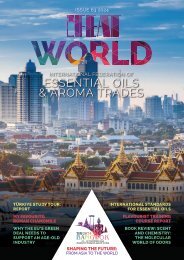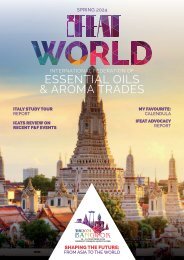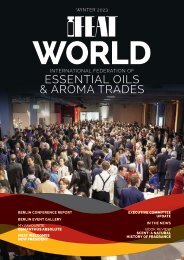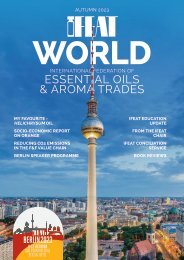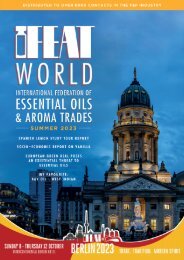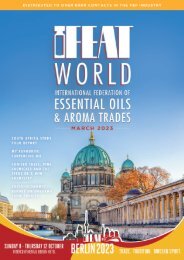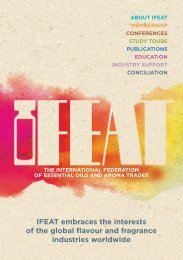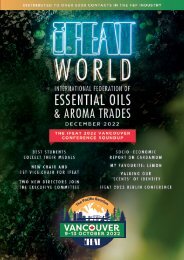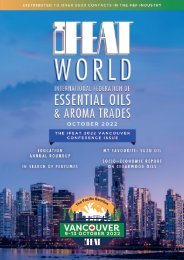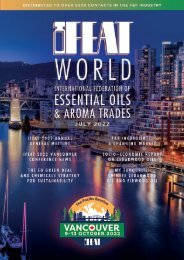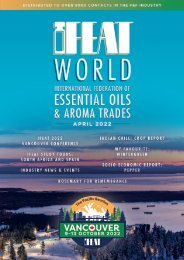IFEATWORLD June 2017
Create successful ePaper yourself
Turn your PDF publications into a flip-book with our unique Google optimized e-Paper software.
WORLD 11<br />
focused on obtaining high quality resins<br />
for the markets. This change in attitude is<br />
very promising for the conservation of the<br />
indigenous resin producing trees.<br />
There are also various marketing constraints,<br />
which include changes in market demand,<br />
little marketing or trade registration<br />
(including very limited export or import<br />
statistics) and the threat from synthetic<br />
products. However, the use of F & M<br />
depends on their characteristic fragrance<br />
properties rather than functional properties<br />
and this makes it much more difficult for<br />
them to be substituted.<br />
VOLUMES:<br />
Frankincense is traded in the greatest<br />
volumes and is available in the largest<br />
number of different grades. It ranges in<br />
appearance from pale pieces or tears up<br />
to several centimeters in size, to smaller<br />
pieces, and from powder and siftings to<br />
large, reddish-brown or dark agglomerated<br />
masses. Myrrh is traded in smaller volumes<br />
and has fewer clean, pale grades to<br />
choose from. All the resins have a fragrant<br />
aroma due to the presence of essential<br />
oil and this accounts for their commercial<br />
importance.<br />
It is difficult to trace the exact volume of<br />
trade in F & M. In very recent years, France,<br />
the UK and the USA have been reported<br />
as sizeable importers of frankincense resins<br />
for further processing. Delauney (2010)<br />
estimated that at least 400 MT per year<br />
(and probably more) of the carterii or sacra<br />
type goes into the fragrance industry. This<br />
canbe differentiated from the Ethiopian<br />
type, which is exported in much larger<br />
volumes and thus the Eritrean or church type<br />
of frankincense accounts for the majority<br />
of incense tradedaround the world.<br />
Delauney estimates that averageannual<br />
exports over the two decades (1987 to<br />
2006) of B. carterii and B. sacra from<br />
Somalia, Somaliland and Puntland have<br />
averaged460MT, while exports of B.<br />
frereana havebeen between 50 and 70<br />
MT. Yemen and Omanare estimated to<br />
export approximately 120MTeach year of<br />
B. carterii and B. sacra and 60MT of B.<br />
frereana, including an unknown quantity<br />
of gum resins that originate from Somalia/<br />
Somaliland and transit through these<br />
countries. Exports of frankincense from<br />
Ethiopia and Eritrea are much larger, with<br />
annual exports of B. papyrifera estimated<br />
at 2,300MT with a further 700 to 800MT<br />
from other sub-Saharan producers. More<br />
recently, Guelleh (2016) has estimated<br />
current annual Somaliland harvesting levels<br />
and potential as follows: B. carterii gum<br />
resin production 200 MT to potentially<br />
around 1,000 MT; B. frereana gum<br />
production 150 MT to potentially 400 MT;<br />
myrrh production 90 MT to potentially 400<br />
MT; and opoponax current production 6<br />
MT to potentially 40 MT. Harris (2016),<br />
while recognising the inadequate data,<br />
discusses the substantial fall in Omani<br />
frankincense annual production to around<br />
30 MT, with harvesting totally dependent<br />
upon immigrant Somali labour.<br />
Coppen in Chikamai and Casadei eds.<br />
(2005) stated “Total world demand is<br />
estimated at around 2,500 tonnes/year but<br />
this figure is subject to some qualification<br />
and much uncertainty. China and Europe<br />
are the largest markets but the Middle East,<br />
North Africa and (to a lesser degree) the<br />
US also import significant amounts directly<br />
from source.”<br />
Today, with no official statistics with regard<br />
to export destinations, one can safely argue<br />
that China and the Middle East (and to a<br />
lesser extent Europe) have definitely become<br />
the largest importers. Although a significant<br />
proportion of imports in the Middle<br />
East are re-exported, China purchases<br />
for medicinal applications and also for<br />
burning incense sticks, whereas Europe<br />
and America use a similar type of incense<br />
(the Eritrean type) in the Orthodox and<br />
Roman Catholic Churches. The Northern<br />
African and Middle East destinations import<br />
the “Maidi” and the “Luban Maidi” for<br />
chewing gum and there are sizeable sales<br />
in local markets for chewing uses. France<br />
is certainly the leading importer of the<br />
B. carterii or B. sacra for perfumery and<br />
fragrance use, including essential oils and<br />
resinoids. In recent years, the popularity<br />
of aromatherapy and self-medication with<br />
essential oils has contributed significantly<br />
to a rise in the international demand for<br />
frankincense and myrrh. Similarly Boswellia<br />
resins are used for their antiseptic, antiarthritic<br />
and anti-inflammatory effects, while<br />
recent German, Indian and US research has<br />
indicated their use as a possible treatment<br />
for cancer.<br />
COMMIPHORA<br />
MYRRHA (MYRRH)<br />
IFEAT/IFRA SOCIO-ECONOMIC IMPACT STUDY OF THE “NATURALS” • FRANKINCENSE AND MYRRH




